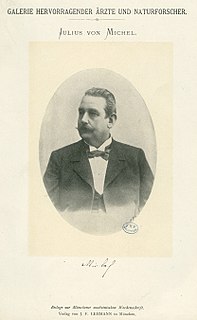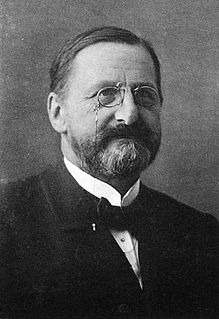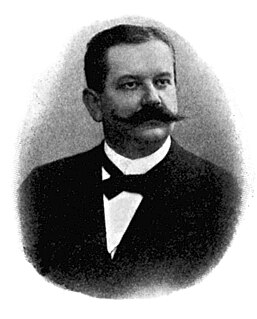
Hermann Kuhnt (14 April 1850 – 31 October 1925) was a German ophthalmologist born in Senftenberg, Brandenburg.

Senftenberg is a town in southern Brandenburg, Germany, capital of the Oberspreewald-Lausitz district. The river Schwarze Elster runs through Senftenberg and the town is located on the shores of Senftenberger See, one of the largest artificial lakes in Germany.

Brandenburg is a state of Germany.
Contents
He studied medicine in Bonn, Berlin and Würzburg, and following graduation worked at the anatomy institute in Rostock under Friedrich Sigmund Merkel (1845–1919). Afterwards he became assistant to ophthalmologist Otto Becker (1828–1890) at the University Eye Clinic in Heidelberg. In 1880 he moved to the University of Jena, where in 1881 he was appointed professor of ophthalmology. Around 1892 he began serving as a professor at the University of Königsberg.

The Federal City of Bonn is a city on the banks of the Rhine in the German state of North Rhine-Westphalia, with a population of over 300,000. About 24 km (15 mi) south-southeast of Cologne, Bonn is in the southernmost part of the Rhine-Ruhr region, Germany's largest metropolitan area, with over 11 million inhabitants. It is famously known as the birthplace of Ludwig Van Beethoven in 1770. Beethoven spent his childhood and teenage years in Bonn.

Berlin is the capital and largest city of Germany by both area and population. Its 3,748,148 (2018) inhabitants make it the second most populous city proper of the European Union after London. The city is one of Germany's 16 federal states. It is surrounded by the state of Brandenburg, and contiguous with its capital, Potsdam. The two cities are at the center of the Berlin-Brandenburg capital region, which is, with about six million inhabitants and an area of more than 30,000 km², Germany's third-largest metropolitan region after the Rhine-Ruhr and Rhine-Main regions.

Würzburg is a city in the region of Franconia, northern Bavaria, Germany. Located on the Main River, it is the capital of the Regierungsbezirk of Lower Franconia. The regional dialect is East Franconian.
From 1870 he was a member of the Corps Rhenania Bonn. [1]

In 1899 with Julius von Michel (1843–1911), he founded the ophthalmic journal Zeitschrift für Augenheilkunde. The following two eponyms are named after him:

Julius von Michel was a German ophthalmologist born in Frankenthal.
- Kuhnt-Junius degeneration: Also known as disciform macular degeneration; [2] named with Paul Junius (1871–1948).
- Kuhnt's spaces: Shallow diverticula or recesses between the ciliary body and the Zonule of Zinn which open into the eye's posterior chamber. [3]

Macular degeneration, also known as age-related macular degeneration, is a medical condition which may result in blurred or no vision in the center of the visual field. Early on there are often no symptoms. Over time, however, some people experience a gradual worsening of vision that may affect one or both eyes. While it does not result in complete blindness, loss of central vision can make it hard to recognize faces, drive, read, or perform other activities of daily life. Visual hallucinations may also occur but these do not represent a mental illness.

The ciliary body is a part of the eye that includes the ciliary muscle, which controls the shape of the lens, and the ciliary epithelium, which produces the aqueous humor. The vitreous humor is produced in the non-pigmented portion of the ciliary body. The ciliary body is part of the uvea, the layer of tissue that delivers oxygen and nutrients to the eye tissues. The ciliary body joins the ora serrata of the choroid to the root of the iris.

The zonule of Zinn is a ring of fibrous strands forming a zonule that connects the ciliary body with the crystalline lens of the eye. These fibers are sometimes collectively referred to as the suspensory ligaments of the lens, as they act like suspensory ligaments.









